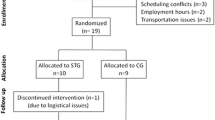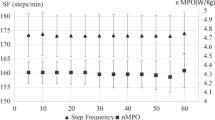Abstract
This study investigated acute changes in muscle activation and muscular power performance after three different running exercises in elite long-distance runners. Twenty-two nationally and internationally ranked long-distance runners performed first an incremental treadmill running test until exhaustion (MR) and then 40 min continuous (TR) and intermittent (2 min run/2 min rest) (IR) running exercises at an intensity of 80 and 100% of the velocity associated with VO2max, respectively. Muscle activation and muscular power performance tests (counter-movement jumps, CMJ, and a set of ten maximal half squats from the static starting position with an extra load of 35% of the subjects,´ one repetition maximum) were performed before and immediately after the runs. The average mechanical power (P) of the half squats was calculated and the root mean square electromyogram (EMGrms) from the vastus lateralis, vastus medialis, gastrocnemius and biceps femoris muscles was recorded simultaneously during the half squat performances. The results showed an acute exercise–induced increase in P (ANOVA time effect, P=0.000) together with a reduction in EMGrms of the knee extensor muscles (ANOVA time effect, P=0.000). However, mechanical P expressed as a relative change within the set decreased after MR. In TR the improvement in P correlated positively with the maximal running performance of the runners (P<0.05), while in IR it correlated negatively (P<0.05). Jumping performance was significantly enhanced after each run (P<0.001, for all) and the improvement correlated negatively with the maximal sprinting speed and maximal jumping height of the runners (P<0.01, for all). It is concluded that in elite long distance runners an intensive prolonged running exercise reduces the surface EMG of the knee extensor muscles, and may lead to a different coordination strategy in leg extension exercises performed into the vertical direction. After continuous type of running the power improvement correlates positively with maximal endurance running capacity, whereas after intermittent type of running it correlates negatively.



Similar content being viewed by others
References
Aagaard P, Andersen JL, Dyhre-Poulsen P, Leffers A-M, Wafner A, Magnusson SP, Halkjaer-Kristensen J, Simonsen EB (2001) A mechanism for increased contractile strength of human pennate muscle in response to strength training: changes in muscle architecture. J Physiol 534:613–623
Aagaard P, Simonsen EB, Andersen PM, Dyhre-Poulsen P (2002) Increased rate of force development and neural drive of human skeletal muscle following resistance training. J Appl Physiol 93:1318–1326
Aagaard P (2003) Training-induced changes in neural function. Exerc Sport Sci Rev 3:61–67
Asmussen E (1979) Muscle fatigue. Med Sci Sports Exerc 1:313–321
Åstrand P-O (1992) Endurance Sports. In: Shephard RJ, Åstrand P-O (eds) Endurance in sports. Blackwell, Oxford, pp8–10
Bigland-Ritchie B (1981a) EMG and fatigue of human voluntary and simulated contractions. In: Human Muscle Fatigue: Physiological Mechanisms. Pitman Medical, London (Ciba Foundation Symposium 82), pp130–156
Bigland-Ritchie B (1981b) EMG/force relations and fatigue of human voluntary contractions. Exerc Sport Sci 9:75–117
Billat V, Renoux JC, Pinoteau J, Petit B, Koralsztein J-P (1994) Reproducibility of running time to exhaustion at VO2max in subelite runners. Med Sci Sports Exerc 26:254–257
Billat V, Renoux JC, Pinoteau J, Petit B, Koralsztein J-P (1995) Times to exhaustion at 90, 100 and 105% of velocity at VO2max (maximal aerobic speed) and critical speed in elite long distance runners. Arch Physiol Biochem 103:129–135
Billat VL, Hill DW, Pinoteau J, Petit B, Koralsztein J-P (1996) Effect of protocol on determination of the velocity at VO2max and its time to exhaustion. Arch Physiol Biochem 313–321
Billat VL (2001) Interval training for performance: a scientific and empirical practice. Sports Med 31:13–32
Bosco C, Viitasalo J (1982) Potentiation of myoelectrical activity of human muscles in vertical jumps. Electromyogr Clin Neurophysiol 22:549–562
Bosco C, Luhtanen P, Komi PV (1983) A simple method for measurement of mechanical power in jumping. Eur J Appl Physiol 50:273–282
Bosco C, Belli A, Astrua M, Tihanyi J, Pozzo R, Kellis S, Tsarpela O, Foti C, Manno R, Tranquilli C (1995) Dynamometer for evaluation of dynamic muscle work. Eur J Appl Physiol 70:379–386
Bosco C, Colli R, Bonomi S, Von Duvillard SP, Viru A (2000) Monitoring strength training: neuromuscular and hormonal profile. Med Sci Sports Exerc 32:202–208
Clark GT, Carter MC (1985) Electromyographic study of human jaw-closing muscle endurance, fatigue and recovery at various isometric force levels. Arch Oral Biol 30:563–569
Davies CTM, Thompson MW (1986) Physiological responses to prolonged exercises in ultramarathon athletes. J Appl Physiol 61:611–617
Enoka RM (1994) Neuromechanical basis of kinesiology. Human Kinetics, Champaign, IL, pp281–289
Ferretti G, Maristella G, Di Prampero PE, Ceretelli P (1987) Effects of exercise on maximal instantaneous muscular power of humans. J Appl Physiol 62:2288–2294
Gandevia SC (1998) Neural control in human muscle fatigue: changes in muscle afferents, moto neurones and moto cortical drive. Acta Phys Scand 162:275–283
Gandevia SC (2001) Spinal and supraspinal factors in human muscle fatigue. Physiol Rev 81:1725–1789
Hirvonen J, Nummela A, Rusko H, Rehunen S, Härkönen M (1992) Fatigue and changes of ATP, creatine phosphate, and lactate during the 400-m sprint. Can J Sport Sci 17:141–144
Häkkinen K, Komi PV, Alen M (1985) Effects of explosive type strength training on isometric force- and relaxation time, electromyographic and muscle fibre characteristics of leg extensor muscles. Acta Physiol Scand 125:587–600
Häkkinen K, Komi PV (1986) Effects of fatigue and recovery on electromyographic and isometric force- and relaxation-time characteristics of human skeletal muscle. Eur J Appl Physiol 55:588–596
Häkkinen K (1993) Neuromuscular fatigue and recovery in male and female athletes during heavy resistance exercise. Int J Sports Med 14:53–59
Komi PV (1986) Training of muscle strength and power: interaction of neuromotoric, hypertrophic, and mechanical factors. Int J Sports Med 7(suppl 1):10–15
Kraemer WJ, Marchitelli L, Gordon SE, Harman E, Dziados JE, Mello R, Frykman P, McCurry D, Fleck SJ (1990) Hormonal and growth factor responses to heavy resistance exercise protocols. J Appl Physiol 69:1442–14450
Lattier G, Millet GY, Martin A, Martin V (2004) Fatigue and recovery after high-intensity exercise. Part I: Neuromuscular fatigue. Int J Sports Med 25:450–456
Lepers R, Hausswirth C, Maffiuletti N, Brisswalter J, Van Hoecke J (2000a) Evidence of neuromuscular fatigue after prolonged cycling exercise. Med Sci Sports Exerc 32:1880–1886
Lepers R, Pousson ML, Maffiuletti NA, Martin A, Van Hoecke J (2000b) The effects of a prolonged running exercise on strength characteristics. Int J Sports Med 21:275–280
Lepers R, Millet GY, Maffiuletti NA (2001) Effects of cycling cadence on contractile and neural properties of knee extensors. Med Sci Sports Exerc 33:1882–1888
Lepers R, Maffiuletti NA, Rochette L, Brugniaux J, Millet GY (2002) Neuromuscular fatigue during a long-duration cycling exercise. J Appl Physiol 92:1487–1493
Lindsay FH, Hawley JA, Myburgh KH, Schomer HH, Noakes TD, Dennis SC (1996) Improved athletic performance in highly trained cyclists after interval training. Med Sci Sports Exerc 28:1427–1434
MacIntosh BR, Rassier DE (2002) What is fatigue? Can J Appl Physiol 27:42–55
Millet GY, Lepers R, Lattier G, Martin V, Babault N, Maffiuletti N (2000) Influence of ultra-long term fatigue on oxygen cost of two types of locomotion. Eur J Appl Physiol 83:376–380
Millet GY, Lepers R, Maffiuletti NA, Babault N, Martin V, Lattier G (2002) Alterations of neuromuscular function after an ultramarathon. J Appl Physiol 92:486–492
Millet GY, Martin V, Lattier G, Ballay Y (2003) Mechanisms contributing to knee extensor strength loss after prolonged running exercise. J Appl Physiol 94:193–198
Millet GY, Lepers R (2004) Alterations of neuromuscular function after prolonged running, cycling and skiing exercises. Sports Med 34:105–116
Nicol C, Komi PV, Marconnet P (1991a) Fatigue effects of marathon running on neuromuscular performance. I Changes in muscular force and stiffness characteristics. Scand J Med Sci Sports 1:10–17
Nicol C, Komi PV, Marconnet P (1991b) Fatigue effects of marathon running on neuromuscular performance. II Changes in force, integrated electromyographic activity and endurance capacity. Scand J Med Sci Sports 1:18–24
Paavolainen L, Häkkinen K, Nummela A, Rusko H (1994) Neuromuscular characteristics and fatigue in endurance and sprint athletes during a new anaerobic power test. Eur J Appl Physiol 69:119–126
Paavolainen L, Nummela A, Rusko H, Häkkinen K (1999) Neuromuscular characteristics and fatigue during 10 km running. Int J Sports Med 20:1–6
Place N, Lepers R, Deley G, Millet GY (2004) Time course of neuromuscular alterations during a prolonged running exercise. Med Sci Sports Exerc 36:1347–56
Psek JA, Cafarelli E (1993) Behaviour of co-active muscles during fatigue. J Appl Physiol 74:170–175
Rassier DE, MacIntosh BR (2000) Coexistence of potentiation and fatigue in skeletal muscle. Braz J Med Biol Res 33:499–508
Sirin AV, Patala AE (1987) Myoelectric changes in the triceps surae muscles under sustained contractions. Evidence for synergism. Eur J Appl Physiol 56:238–244
Strojnik V, Komi PV (2000) Fatigue after submaximal intensive stretch-shortening cycle exercise. Med Sci Sports Exerc 32:1314–1319
Vigreux B, Cnockaert JC, Perutzon E (1989) Effects of fatigue on the series elastic component on human muscle. Eur J Appl Physiol 45:11–17
Viitasalo JT, Bosco C (1982) Electromechanical behaviour of human skeletal muscles in vertical jumps. Eur J Appl Physiol 48:253–261
Viitasalo JT, Komi PV, Jacobs I, Karlsson J (1982) Effects of prolonged cross-country skiing on neuromuscular performance. In: Komi PV (ed) Exercise and Sport Biology. International Series on Sport Sciences, vol. 12. Human Kinetics, Champaign, IL, pp 191–198
Vuorimaa T, Häkkinen K, Vähäsöyrinki P, Rusko H (1996) Comparison of three maximal anaerobis running test protocols in marathon runners, middle distance runners and sprinters. Int J Sports Med 17(suppl 2):S109-S113
Vuorimaa T, Vasankari T, Rusko H (2000) Comparison of physiological strain and muscular performance of athletes during two intermittent running exercises at the velocity associated with VO2max. Int J Sports Med 21:96–101
Acknowledgements
This study was partly supported by the National Technology Agency of Finland
Author information
Authors and Affiliations
Corresponding author
Rights and permissions
About this article
Cite this article
Vuorimaa, T., Virlander, R., Kurkilahti, P. et al. Acute changes in muscle activation and leg extension performance after different running exercises in elite long distance runners. Eur J Appl Physiol 96, 282–291 (2006). https://doi.org/10.1007/s00421-005-0054-z
Accepted:
Published:
Issue Date:
DOI: https://doi.org/10.1007/s00421-005-0054-z




